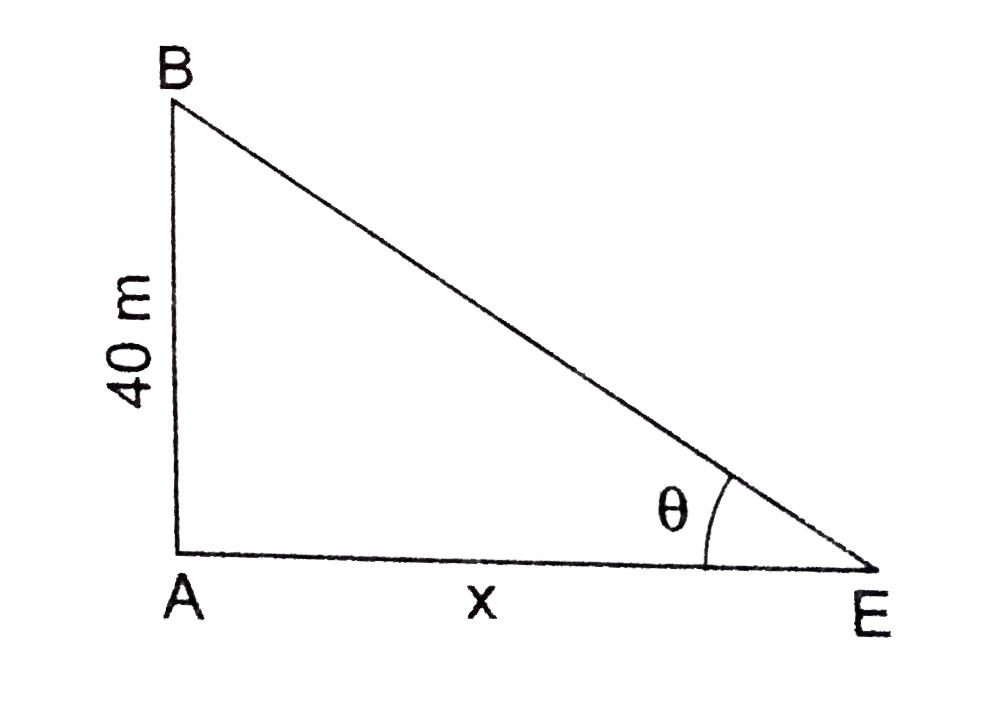A man is walking away from the foot of a tower of height 40m at the rate of 4km/hour.Find the rate at which his distance from the top of the tower is increasing when he is 30m away from the bottom of the tower.
To solve the problem, we will follow these steps:
Step 1: Understand the Problem
We have a tower of height 40 meters, and a man is walking away from the base of the tower at a rate of 4 km/h. We need to find the rate at which his distance from the top of the tower is increasing when he is 30 meters away from the base of the tower.
Step 2: Set Up the Geometry
Let:
- AC be the height of the tower = 40 m.
- AB be the distance from the man to the base of the tower = x m.
- BC be the distance from the man to the top of the tower = y m.
We can form a right triangle ABC where:
- AB=x
- AC=40
- BC=y
Step 3: Apply the Pythagorean Theorem
From the right triangle, we have:
y2=x2+402
This simplifies to:
y2=x2+1600
Step 4: Differentiate with Respect to Time
Now, we differentiate both sides with respect to time t:
ddt(y2)=ddt(x2+1600)
Using the chain rule:
2ydydt=2xdxdt
Step 5: Solve for dydt
Rearranging gives:
dydt=xy⋅dxdt
Step 6: Substitute Known Values
We know:
- dxdt=4 km/h (which we need to convert to meters per hour: 4×1000=4000 m/h)
- When the man is 30 m away from the tower, x=30 m.
First, we need to find y when x=30:
y2=302+402=900+1600=2500
Thus,
y=√2500=50 m
Step 7: Calculate dydt
Now substituting x=30, y=50, and dxdt=4000 m/h into the equation:
dydt=3050⋅4000=35⋅4000=2400 m/h
Step 8: Convert to km/h
To convert this to kilometers per hour:
24001000=2.4 km/h
Final Answer
The rate at which the distance from the top of the tower is increasing when the man is 30 m away from the base of the tower is 2.4 km/h.
---
We have a tower of height 40 meters, and a man is walking away from the base of the tower at a rate of 4 km/h. We need to find the rate at which his distance from the top of the tower is increasing when he is 30 meters away from the base of the tower.
Let:
- AC be the height of the tower = 40 m.
- AB be the distance from the man to the base of the tower = x m.
- BC be the distance from the man to the top of the tower = y m.
- AB=x
- AC=40
- BC=y
From the right triangle, we have:
y2=x2+402
This simplifies to:
y2=x2+1600
Now, we differentiate both sides with respect to time t:
ddt(y2)=ddt(x2+1600)
Using the chain rule:
2ydydt=2xdxdt
Rearranging gives:
dydt=xy⋅dxdt
We know:
- dxdt=4 km/h (which we need to convert to meters per hour: 4×1000=4000 m/h)
- When the man is 30 m away from the tower, x=30 m.
y2=302+402=900+1600=2500
Thus,
y=√2500=50 m
Now substituting x=30, y=50, and dxdt=4000 m/h into the equation:
dydt=3050⋅4000=35⋅4000=2400 m/h
To convert this to kilometers per hour:
24001000=2.4 km/h
The rate at which the distance from the top of the tower is increasing when the man is 30 m away from the base of the tower is 2.4 km/h.
Topper's Solved these Questions
Similar Questions
A man is moving away from a tower 41.6 m high at the rate of 2 m/sec. Find the rate at which the angle of elevation of the top of tower is changing, when he is at a distance of 30m from the foot of the tower. Assume that the eye level of the man is 1.6m from the ground.
View SolutionA man is moving away from a 40-m high tower at a speed of 2 m/s. Find the rate at which the angle of elevation of the top of the tower is changing when he is at a distance of 30 metres from the foot of the tower. Assume that the eye level of the man is 1.6 m from the ground.

View Solution
Knowledge Check
From 40 m away from the foot of a tower , the angle of elevation of the top of the tower is 60∘ .What is the height of the tower ?
A120√3 m .B60√3 m .C50√3 m .D130√7m .A man is moving away from a tower 41.6m high at a rate of 2ms−1. If the eye level of the man is 1.6m above the ground, then the rate at which the angle of elevation of the top of the tower changes, when he is at a distance of 30 m from the foot of the tower, is:
A−4125 radian/sB225 radian/sC−1625 radian/sDNone of theseThe angle of elevation of the top of a tower of height 100√3m from a point at a distance of 100 m from the foot of the tower on a horizontal plane is
A60∘B90∘C120∘D180∘
A man is walking at the rate of 6.5 km/hr towards the foot of a tower 120m high. At what rate is he approaching the top of the tower when he is 5m away from the tower?
View SolutionA man standing 30ms South of a tower of height h walks 60 m to the East and finds the angle of elevation of the top of the tower to 30∘. Find h.
View Solution80 m away from the foot of the tower, the angle of elevation of the top of the tower is 60∘. What is the height (in metres) of the tower?
View SolutionThe angle of elevation of the top of a tower of height 100√3m from a point at a distance of 100 m from the foot of the tower on a horizontal plane is
View SolutionAt a point 20 m away from the foot of a tower, the angle of elevation of the top of the tower is 30∘ The height of the tower is
View Solution
